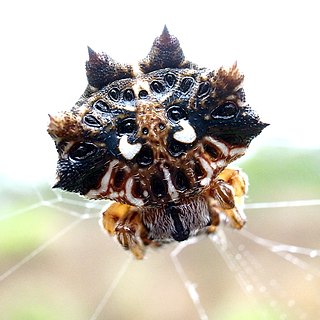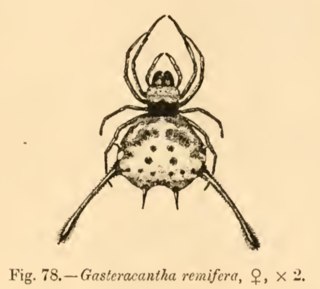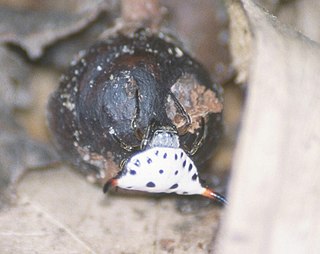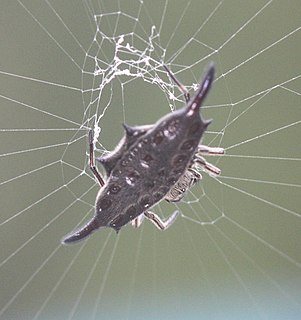
Austracantha is a genus of spider with a single species, Austracantha minax, commonly known as the jewel spider or the Christmas spider. It is a member of the family Araneidae and is endemic to Australia. They are relatively small spiders, reaching a maximum total body length of only around 12 mm (0.47 in) for females, and 5 mm (0.20 in) for males. Their abdomen has six distinctive projections ("spines") that makes them easy to identify. They are predominantly a shiny black, with variable white, yellow, and orange patterns. Melanistic forms also occur during autumn. They are facultatively gregarious, and can be found in large aggregations of overlapping orb webs. They feed on small flying insects that get entangled in their webs. They are harmless to humans, though the webs can be a nuisance for bushwalkers. They are most abundant during the summer months.

Gasteracantha is a genus of orb-weaver spiders first named by Carl Jakob Sundevall in 1833. The females of most species are brightly colored with six prominent spines on their broad, hardened, shell-like abdomens. The name Gasteracantha is derived from the Greek gaster (γαστήρ), meaning "belly, abdomen", and akantha (άκανθα), meaning "thorn, spine". Spiny-backed orb-weavers are sometimes colloquially called "crab spiders" because of their shape, but they are not closely related to the true crab spiders. Other colloquial names for certain species include thorn spider, star spider, kite spider, or jewel spider.

Gasteracantha cancriformis is a species of orb-weaver spider. It is widely distributed in the New World.

Thelacantha is a genus of orb-weaver spiders containing the single species, Thelacantha brevispina. It was first described by A. W. M. van Hasselt in 1882, and has been found in Australia, Madagascar, and across southern Asia from India to Philippines, including Japan. It has also been introduced into Hawaii. T. brevispina is closely related those in the genus Gasteracantha, and was briefly synonymized with it in 1859, but revalidated in 1974. Saito described three other Thelacantha species in 1933, which were later synonymized with T. brevispina.

Eucteniza is a genus of trapdoor spiders in the family Euctenizidae containing at least 14 species occurring in Mexico and the southern United States. Species are distinguished by a softened rear portion of the carapace, and males possess large spines on the first two pairs of walking legs that are used to hold females during mating. Like other trapdoor spiders they create burrows with a hinged lid, from which they await passing insects and other arthropods to prey upon. Many species are known from only one or two localities, or from only male specimens. More species are expected to be discovered. Eucteniza is closely related to spiders of the genera Entychides and Neoapachella.

Theridiosoma gemmosum is a species of spider in the family Theridiosomatidae, known as ray spiders. It is widely distributed in the Holarctic region. A small spider with a shiny globular abdomen, it constructs a conical orb web.

Gasteracantha remifera is a species of spiny orb-weaver spider in the genus Gasteracantha. It is found in Sri Lanka and India, and it has a pair of long, club-shaped spines on its abdomen.

Friula is a genus of orb-weaver spiders containing the single species, Friula wallacei. It was first described by O. Pickard-Cambridge in 1897, and has been found only on Borneo. Pickard-Cambridge based his description and drawing on a specimen collected by Alfred Russel Wallace in Sarawak between November 1854 and January 1856. Pickard-Cambridge personally confirmed with Wallace that Wallace "was the captor of this spider, and in the locality mentioned." In 2017, the Alfred Russel Wallace Memorial Fund published a call for observations of this species, stating that no specimens of the species have been collected since Wallace's and that his specimen, housed at Oxford University, is the only known specimen in the world.

Macracantha is a genus of Asian orb-weaver spiders recognized as containing a single species, Macracantha arcuata. Macracantha is notable for the extremely long, curved spines on the abdomens of female members of the genus; Eugène Simon created the taxon name from the Greek words μακρός and ἄκανθα (spine). It occurs from India and China through Southeast Asia to Borneo.

Togacantha is a genus of orb-weaver spiders found in Africa. It is monotypic and contains the single species Togacantha nordviei. It was first described as a subgenus of Gasteracantha by Friedrich Dahl in 1914, and was later elevated to genus status. Only the female was known until a male was found and described in 1982.

Gasteracantha kuhli is a species of spiny orb-weaver spider in the genus Gasteracantha, widespread from India to Japan, the Philippines, and Java in Indonesia. It is known as the black-and-white spiny spider.

Gasteracantha clavigera is a species of spider in the spiny orb-weaver genus Gasteracantha.

Gasteracantha diardi is a species of spider in the spiny orb-weaver genus Gasteracantha. It occurs in Southeast Asia.

Gasteracantha mengei is a species of spider in the spiny orb-weaver genus Gasteracantha. Its range includes Peninsular Malaysia, Singapore, Borneo, and Sumatra in Indonesia.

Gasteracantha quadrispinosa, the four-spined jewel spider, is a brightly coloured species of spider in the spiny orb-weaver genus Gasteracantha. It occurs in wet forests of Queensland, Australia, and New Guinea, where it builds vertical orb webs approximately 1.5 m across and hangs in the centre of the web to wait for prey.

Gasteracantha westringi is a species of spiny orb-weaver spider in the genus Gasteracantha. It is found in Australasia, including New Caledonia and Norfolk Island, and it has a wing-shaped abdomen armed with red and black spines.

Gasteracantha gambeyi is a species of spiny orb-weaver spider in the genus Gasteracantha. It was described from New Caledonia.

Gasteracantha interrupta is a species of spiny orb-weaver spider in the genus Gasteracantha. It is black and white in color, and it occurs in the Lesser Sundas and Sulawesi in Indonesia.

Gasteracantha recurva is a species of spiny orb-weaver spider in the genus Gasteracantha. It was described from Manila, Philippines in 1877.

Gasteracantha hecata is a species of spider in the spiny orb-weaver genus Gasteracantha. It occurs in the Philippines and has prominent horn-like spines on its abdomen.




















